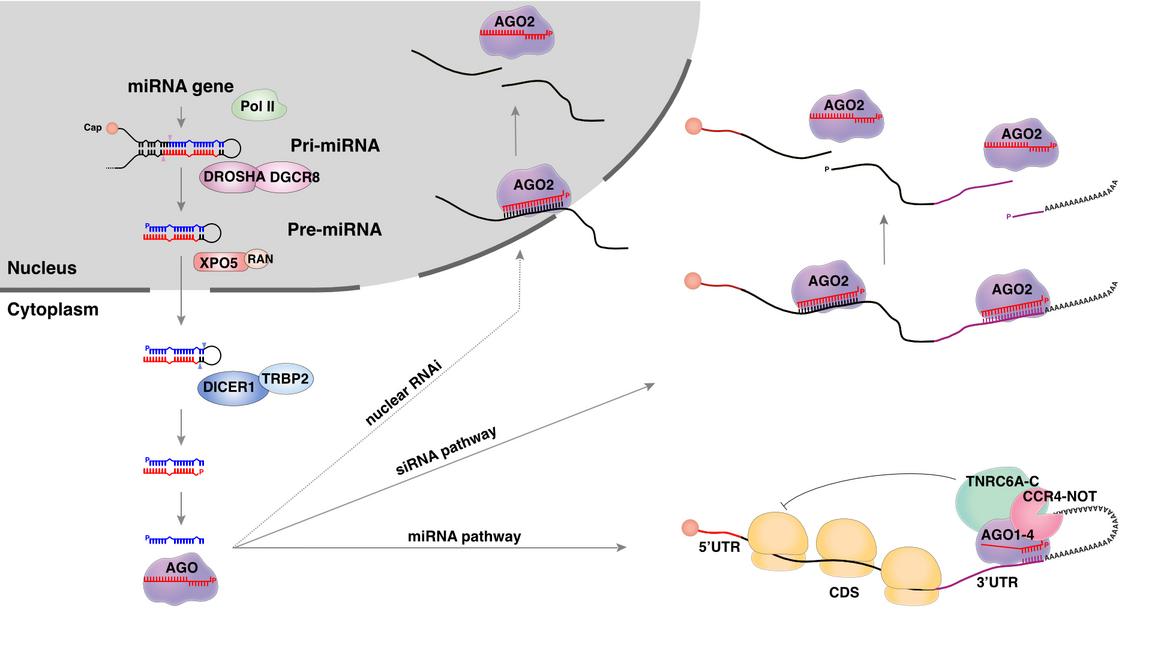
Aishe Sarshad Group
Short description
Aishe Sarshad, PhD. Associate Senior Lecturer (Assistant Professor) in Biomedicine.
Research Summary

Non-coding RNAs and AGOs in Health and Disease
Argonaute (AGO) proteins, loaded with small interfering RNAs (siRNAs) or microRNAs (miRNAs), are the core components of RNA induced silencing complex (RISC). The small RNAs guide the AGO ribonucleoprotein to complementary target RNAs resulting in gene silencing. microRNAs (miRNAs), 21-23 nucleotide long non-coding RNA molecules, are expressed in a cell type-specific manner and can accumulate to tens of thousands of copies per cell. It is estimated that up to 60% of human genes are under miRNA regulation. miRNA silencing pathways play important roles in a number of biological processes, including embryonic stem cell differentiation and tissue development. Deregulation of this pathway is associated with various diseases; therefore, it is essential to fully understand the molecular mechanisms of miRNA regulation.
We recently discovered that key factors of the RISC silencing complex are expressed in the nucleus of embryonic stem cells. Our current work aims at decoding the regulatory pathways of nuclear RISC. Specifically, we want to understand why stem cells need nuclear miRNA-Argonaute complexes for gene regulation and how these play a role during stem cell differentiation and reprograming. We further aim to understand if nuclear RNA interference by RISC can be used in cancers as a way of targeting nuclear factors important in cancer development.

Contact Information
Department of Medical Biochemistry and Cell biology
Phone +46 31-786 57 04
Mail: aishe.sarshad@gu.se
Visiting Address
Medicinaregatan 9 a-b
41390 Göteborg
Postal Address
Box 440
40530 Göteborg
More information
Grants and Awards
Establishment grants:
- 2020 Tenure-track position with Wallenberg Center for Molecular and Translational Medicine
- 2019 Swedish Society for Medical research (SSMF)
- 2019 The Swedish Research council (VR)
Project funding
- 2021 Åke Wiberg foundation (awarded 2019, 2020 and 2021)
- 2021 Magnus Bergvall foundation (awarded 2019, 2020 and 2021)
- 2021 Ollie och Elof Ericsson foundation (awarded 2020 and 2021)
- 2020 Cornell foundation (awarded 2019 and 2020)
- 2020 The Swedish Medical Society (SLS)
- 2020 Jeansson foundation
- 2020 AG-Fonden (Awarded 2019 and 2020)
- 2020 Carl Trygger foundation
- 2019 Gunvor och Josef Anérs foundation
- 2018 Olle Engkvist foundation
- 2018 Sahlgrenska Academy Returning Grant
Awards:
- 2019 L’Oréal-UNESCO for Women in Science Award, Sweden
- 2016 Fellow Award Research Excellence (FARE), NIH
Postdoc grants:
- 2016 The Swedish Research council (VR)
- 2016 Swedish Society for Medical research (SSMF) – declined

Vivian Lobo, Postdoctoral fellow
- PhD in Reproductive Medicine, University of Mumbai, India
- MSc, in Biotechnology, University of Mumbai, India
- BSc, in Biotechnology, University of Mumbai, India

Carola Fernandez, Postdoctoral fellow
- PhD in Medical Biology University of Montpellier, France
- MSc in Stem cell and developmental Biology, Sorbonne University, France
- BSc in Life Science biology, Sorbonne University, France
Iwona Nowak, Postdoctoral fellow
-
PhD in Biochemistry, biophysics and Biotechnology, University of Jagiellonian University, Poland
- MSc in Biotechnology, University of Jagiellonian University, Poland
- BSc in Biotechnology, University of Jagiellonian University, Poland

Ulrika Alexandersson, Lab manager (shared with Maria Falkenberg)
- BSc University of Gothenburg, Sweden
Alumni
Isra Hamzo, BMA thesis student
Wail Chrifi, Technician
News and media
- Barnbok ska väcka nyfikenhet för forskning [Swedish article]
- Aishe Sarshad är en av 60 forskare i ny bok som ska väcka barns nyfikenhet för forskning [Swedish article]
- Aishe Sarshad tog emot fint pris för kvinnliga forskare [Swedish article]
- Göteborgsforskare prisas av FN-organ [Swedish article]
- Hon prisas för sin forskning: "Kanske kan se till att cancer slutar växa" [Swedish news clip]
- Aishe Sarshad - 2019 L'Oréal-UNESCO Laureate for Sweden [Video clip]
- Unga kvinnor belönas för forskning om elektroniska växter och stamceller [Swedish press release]
- Nästan 120 miljoner från Vetenskapsrådet inom medicin och hälsa [Swedish article]
- Storslam för Göteborg från SSMF [Swedish article]
- De får Sahlgrenska Academy International Starting Grant 2018 [Swedish article]
Selected Publications
Nowak I and Sarshad AA#
Argonaute proteins take center stage in cancers.
Cancers (2021) 13(4):788.
doi.org/10.3390/cancers13040788
Muys BR, Sousa JF, Pla.a JR, Ara.jo LF, Sarshad AA, Anastasakis DG, Wang X, Li XL, de Molfetta GA, Ram.o A, Lal A, Vidal DO, Hafner M, Silva WA.
miR-450a acts as a tumor suppressor in ovarian cancer by regulating energy metabolism.
Cancer Research. (2019) Jul 1;79(13):3294-3305.
doi: 10.1158/0008-5472.CAN-19-0490
Sarshad AA, Juan AH, Correa Muler AI, Anastasakis D, Wang X, Genzor P, Feng X, Tsai P, Sun H, Haase AD, Sartorelli V, Hafner M.
Argonaute-miRNA complexes silence target mRNAs in the nucleus of mammalian stem cells.
Molecular Cell. (2018) Sep 20;71(6):1040-1050.e8
doi: 10.1016/j.molcel.2018.07.020.
Gao QQ*, Putzbach WE*, Murmann AE, Chen S, Sarshad AA, Ambrosini G, Bartom ET, Hafner M, and Peter ME.
6mer seed toxicity in tumor suppressive microRNAs.
Nature Communications (2018), Oct 29;9(1):4504.
doi: 10.1038/s41467-018-06526-1.
Tsai P, Dell’Orso S, Rodriguez J, Vivanco KO, Ko K, Jiang K, Juan AH, Sarshad AA, Tran M, Wang D, Wang AH, Anastasakis D, Ralston E, Ried T, Sun H, Hafner M, Larson DR, and Sartorelli V. A
Muscle Super-Enhancer RNA Mediates Cohesin Recruitment and Regulates Transcription in Trans.
Molecular Cell. (2018) Jul 5;71(1):129-141.e8.
doi: 10.1016/j.molcel.2018.06.008.
Benhalevy D*, McFarland HL*, Sarshad AA*, Hafner M.
PAR-CLIP and streamlined small RNA cDNA library preparation protocol for the identification of RNA binding protein target sites.
Methods. (2017) Apr 15;118-119:41-49.
doi: 10.1016/j.ymeth.2016.11.009
Dutka T*, Sarshad AA*, Hafner M.
PAR-CLIP: A Genomic Technique to Dissect RNA-Protein Interactions.
Field Guidelines for Genetic Experimental Designs in High-Throughput Sequencing (2016) pp 261-289.
Doi 10.1007/978-3-319-31350-4

